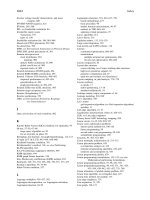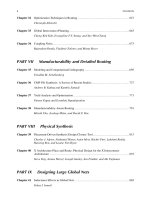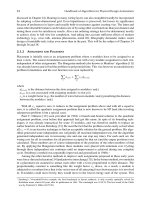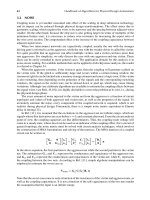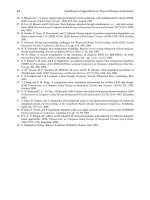- Trang chủ >>
- Khoa Học Tự Nhiên >>
- Vật lý
Handbook of algorithms for physical design automation part 18 ppsx
Bạn đang xem bản rút gọn của tài liệu. Xem và tải ngay bản đầy đủ của tài liệu tại đây (173.13 KB, 10 trang )
Alpert/Handbook of Algorithms for Physical Design Automation AU7242_C008 Finals Page 152 29-9-2008 #15
152 Handbook of Algorithms for Physical Design Automation
or four modules/rectangles at any level with their given connectivity and size specifications takes
constant time.
Another strong motivation for employing a hierarchical approach is that because floorplanning
decisions affect the subsequent phases of placement or global routing, it is desirable to integrate these
phases as much as possible. A hierarchical method makes this computationally feasible as designed
and implemented by Dai et al. [16,39] and Lengauer et al. [40].
As part of the macrocell based layout system called BEAR, the hierarchical floorplanner by
Dai et al. consists of three steps:
Step 1—Bottom-up clustering: A hierarchical tree is constructed in a bo ttom-up fashion
by clustering strongly connected modules greedily. Each cluster has a limited number of
modules, typically upto four. For each cluster, the shapes of the blocks are also considered
so that there is no mismatch within the cluster. Issues with size incompatibility at higher
levels between two neighboring clusters with fewer connections may arise, but these can
be resolved by limiting the sizes of the clusters at the higher levels so that the smaller sized
clusters are d ealt with earlier, thereby reducing the percentage of wasted area.
Step 2—Top-down placement: The cluster tree is traversed from the root, which has its
desired shape and terminals specified. These requirements are propagated to the children
clusters and their respectiveshape and terminals are determined.Thesmall numberofpossi-
ble floorplan templates (Figure8.11) are enumerated and clusters are assigned to rectangles
or rooms in a template to obtain a floorplan topology. In most cases, the winning topology
is determined by computing the estimated routing space for each of the possible topologies.
This is continued till the orientations of the leaf modules are decided. It may be pointed
out that this method works well when the leaf level modules can be of flexible shape. A
certain amount of look ahead to the grandchild level is also added during top-down shape
determination. Th e system allows the user to monitor the trade-off among shape, area, and
connections costs.
Step 3—Floorplan optimization: This step improves the solution obtained above by iter-
atively selecting certain blocks and resizing them. The blocks selected usually lie on the
longest paths through the placement based on th e routing estimates. Such paths are either
between the left and right sides of the chip or the top and bottom sides. The routing cost is
computed by adding the edge weights (number of net connections) between pairs of clusters
multiplied by th e distance between their centers in the current placement. The global routing
information is updated incrementally after each iteration. The stopping criterion is that the
longest paths contain fixed size blocks only or flexible blocks that belong to the longest
path in the perpendicular direction as well. Although this method is very efficient for small
circuits, it n eeds to be executed in a two-pass mode iteratively, one for each direction, to
achieve fast convergence for larger circuits.
In the hierarchical approach taken by Lengauer et al. [40], the hierarchy or cut-tree is g enerated in
a top-down manner by recursive mincut method initially and then the bottom levels of the tree are
obtained by bottom-up clustering. Once again the degree of the cut-tree is restricted to 4. Floorplan
FIGURE 8.11 Some templates used in hierarchical floorplanner BEAR with at most degree 4 branching at
any node of the h ierarchy.
Alpert/Handbook of Algorithms for Physical Design Automation AU7242_C008 Finals Page 153 29-9-2008 #16
Floorplanning: Early Research 153
sizing is done by bottom-up traversal of the cut-tree to compute the floorplan alternatives based
on the shape function for the children modules/rectangles. Finally, a particular floorplan alternative
and its corresponding global routing are constructed simultaneously. For a floorplan topology, there
exists a breadth-first top-down labeling of the nodes of the cut-tree with a particular pattern. The
pattern selection performed at each node is guided by the external wiring costs computed for the
previous cut-tree level without the need for penalty functions à la Dai et al. for assigning modules to
rectangular regions smaller than the requirement. Moreover, the number of patterns is bounded by a
small integer. The sizing algorithm employs shape function instead of the penalty-oriented method
by Dai et al. Thus, this method implemented in the system FRODO reports better results over BEAR.
8.6 FLOORPLAN SIZING METHODS
Given a floorplan topology, the second task is to obtain the aspect ratios of the modules so that the
overall area, total netlength, and maximum netlength is optimal. Some of the major techniques are
listed below and more details of two important ones appear in the subsequent sections.
1. Force-directed with slicing [41]: The PIONEER system is an iterative method. It pro-
vides two capabilities: extraction of initial layout from a user-specified data and interactive
graphics for improving the initial layout. The improvement of initial layout proceeds in
three steps. Fir st, macrocenters are determined, then a slicing structure is generated, and
finally the layout is expanded.
2. Relaxation method [42,43]: This iterative floorplanning method is different from improve-
ment by interchange because relaxation implies an obvious next state. In Ref. [42],
dimensional relaxation is used to improve a floorplan. It consists of modifying the shapes
of cells as well as the topology of the horizontal and vertical line segments that define the
floorplan.
3. Simulated annealing: Timber Wolf [44] is one of the first floorplanning systems based on
simulated annealing technique. It produces not only the relative positions of the modules
but also their aspect ratios and pin positions. The algorithms for optimal floorplan design,
reported in Ref. [21,38], also use simulated annealing. The first algorithm can generate
slicing structures with rectangular modules only, whereas the second one can produce non-
slicing floorplans and even L-shaped modules. A new representation of floorplans using
normalized Polish expressions facilitates selection during iterative improvement by pair-
wise interchange (see Chapter 9 for details). The major disadvantages of these systems are
that they are computation intensive and may not be readily adapted to deal with various
constraints on floorplan.
4. Genetic algorithm [45]: This stochastic iterative method requires appropriate encoding of
a floorplan and its associated cost function along with the definition of effective crossover
and mutation operators for iterative moves. Each move has an activation probability. It
can handle large floorplan s and the quality of the solutions are comparable with simulated
annealing-based methods.
5. Analytic force-directed method with packing [46,47]: Iterativefloorplanning by this method
consists of two subtasks. First, an initial placement is obtained either by potential energy
method, or by attractive and repulsive force method as in the CHAMP system. Then a
semiautomatic block packing process is undertaken by relocating and reshaping modules
as well as the chip boundary. Constraint-based analytic sizing methods have also been
proposed [48–50]; further details are elaborated in the following section.
6. Branch-and-bound[29]: Layouts occupying minimum area can be obtained by this method
using gra ph-theo retic representation of floorplan and suitably f ormulating a network flow
optimization problem. Gr aph-theoretic representation can also yield optimal aspect ratios
of modules in any floorplan by a branch-and-bound heuristic.
Alpert/Handbook of Algorithms for Physical Design Automation AU7242_C008 Finals Page 154 29-9-2008 #17
154 Handbook of Algorithms for Physical Design Automation
8.7 ANALYTIC SIZING
The floorplan sizing algorithms that adopt an analytical approach essentially model the problem as a
set of constraints on the dimensions and connectivities of the rectangular modules such that a certain
objective function is minimized. Among these, a method based on potential energy modeling o f
overlap and separation was proposed by Ying et al. [48]. The shape constraints are met by bounding
penalty functions. An unconstrained minimization problem is then solved heuristically. As the time
complexityis high, theauthors mentionincorporatinghierarchical floorplanningbyusingthe method
recursively.
The most effective and widely re ferred analytic floorplan sizing algorithm based on mixed integer
programming formulation was proposed by Sutanthavibul et al. [49]. The essence of this is described
next. The assumption is that the area of a rectangular module is known a priori, but its actual shape
may be either fixed or flexible within certain limits for the aspect ratios (width to height ratio).
The variables in the mixed integer programming are of two types, namely integer variables (x
i
, y
i
)
indicating the x-andy-coordinates of the lower left corner of module i, and certain 0–1 variables that
primarily take care of different constraints. The width and height of module i is denoted by (w
i
, h
i
).
Constraints for nonoverlap of modules i and j: If both modules are rigid, we have the four linear
inequalities (I.a). Typically, the bounds on the width W and h eight H of the chip m ay be specified. By
employing two 0–1 integer variables x
ij
and y
ij
, we can ensure that at least one of the four inequalities
(I.b) holds for any pair of modules i and j. Thus for any one of the four possible values of (x
ij
, y
ij
),
only one of the four inequalities is applicable, the other three being vacuously true. It is assumed
that for all i, the values of (x
i
, y
i
) are nonnegative and definitely less than the chip width or height as
the case may be.
Constraints for nonoverlap of two rigid modules i and j
x
i
+ w
i
≤ x
j
, i left of jx
i
+ w
i
≤ x
j
+ W(x
ij
+ y
ij
)
x
i
− w
j
≥ x
j
, i right of jx
i
− w
j
≥ x
j
− W(1 −x
ij
+ y
ij
)
y
i
+ h
i
≤ y
j
, i below jy
i
+ h
i
≤ y
j
+ H(1 +x
ij
− y
ij
)
y
i
− h
j
≥ y
j
, i above jy
i
− h
j
≥ y
j
− H(2 −x
ij
− y
ij
)
(I.a) Variable-size chip (I.b) Fixed-size chip
If r otation by 90
◦
is to be permitted for the rigid modules, then an additional 0–1 integer variable
z
i
is introduced and the constraints are modified to the following where M = max(W, H):
x
i
+ z
i
h
i
+ (1 − z
i
)w
i
≤ x
j
+ M(x
ij
+ y
ij
)
x
i
− z
j
h
j
+ (1 −z
j
)w
j
≥ x
j
− M(1 −x
ij
+ y
ij
)
y
i
+ z
i
w
i
+ (1 −z
i
)h
i
≤ y
j
+ M(1 +x
ij
− y
ij
)
y
i
− z
j
w
j
+ (1 − z
j
)h
j
≥ y
j
− M(2 −x
ij
− y
ij
)
Next, modules with flexible shapes but fixed area s
i
are considered in the inequalities (I. c and I.d) by
converting the quadratic relation w
i
h
i
= s
i
to a linear one, i.e., by expressing h
i
as a lin ear function
of w
i
based on the first two terms of the Taylor series expansion about the point w
i max
as given b elow:
h
i
=
s
i
w
i max
+ (w
i max
− w
i
)
s
i
w
2
i max
or, h
i
= h
i0
+ w
i
λ
i
Alpert/Handbook of Algorithms for Physical Design Automation AU7242_C008 Finals Page 155 29-9-2008 #18
Floorplanning: Early Research 155
where h
i0
=
s
i
w
i max
, λ
i
=
s
i
w
2
i max
,andw
i
= w
i max
− w
i
Constraints for nonoverlap of a flexible module i
x
i
+ w
i max
− w
i
≤ x
j
x
i
+ w
i max
− w
i
≤ x
j
y
i
+ h
i0
+ w
i
λ
i
≤ y
j
y
i
+ h
i0
+ w
i
λ
i
≤ y
j
x
i
− w
j
≥ x
j
x
j
+ w
j max
− w
j
≤ x
i
y
i
− h
i
≥ y
j
y
j
+ h
j0
+ w
j
λ
j
≤ y
i
(I.c) With rigid module j (I.d) With flexible module j
Constraints on interconn ection lengthcanalso be thrownin with fewcontinuouspositivevariables
per net and the half-perimeter metric is used. The complexity of the entire mixed integer linear
programming problem may be reduced by considering the constraints for critical nets only as this
number is far smaller. Routability is modeled by linear constraints based on the rule that the total
net length is 0.5 times the length of the routing tracks in the chip. This ensures that enough empty
space around each module is reserved for routing. For each pair of modules, two continuous and one
integer variable is introduced.
The package LINDO is used to solve for the values of the variables and arrive at a floorplan
solution. If the topology is given, then all the 0–1 integer variables acquire specific values and the
problem of determining the shapes of the modules reduces to standard linear programming one and
is hence polynomially solvable. The number of continuous variables and the linear constraints are
respectively 2n and O(n) where the floorplan has n modules.
The major drawback of this approach is the huge solution time for mixed integer linear pro-
gramming. For example, a floorplan with 25 modules may need about 600 integer variables. The
technique devised to overcome this is to consider very few, typically 10–12, modules at a time and
then successively augment the floorplan in a locally optimal way by adding a new group of mod-
ules each time till all modules have been processed. The selection of the groups of modules can be
performed either by clustering based on connectivity or linear ordering depending on the I/O con-
nections. The key to reducing the complexity is to have fewer number of variables, thus the already
positioned modules in a p artial floorplan are replaced by fewer number of covering rectangles. The
floorplanning algorithm by analytical method [49] is given in Algorithm 2.
Algorithm 2 Floorplanning algorithm by mixed integer linear programming [49]
Algorithm MILP_Floorplan
begin
Select a group S of k modules as seed;
Formulate MILP for S;
Solve to generate partial f loorplan for S;
while (k ≤ n)do/ ∗ n is total number of modules ∗/
Select a new group of e modules based on connections to already positioned modules;
Find a set of d covering rectangles for the present partial floorplan where d ≤ k;
Formulate MILP for d covering rectangles and e unpositioned m odules;
Solve to obtain new partial floorplan;
k = k + e;
endwhile;
end.
Alpert/Handbook of Algorithms for Physical Design Automation AU7242_C008 Finals Page 156 29-9-2008 #19
156 Handbook of Algorithms for Physical Design Automation
8.8 BRANCH-AND-BOUND STRATEGY FOR SIZING
One of the early algorithms for optimal sizing of general floorplans with rigid modules was devised
by Wimer et al. [29]. The input to this algorithm is a floorplan topology represented by a pair of
dual polar graphs, also known as the x-graph or horizontal constraint graph, and the y-graph or
vertical constraint graph. Each graph is planar, directed acyclic with a single source and a single sink
corresponding to the left (top) and right (bottom) edges of the bounding rectangle of the floorplan. A
vertex in the x-graph corresponds to a vertical side of a rectangular module in the floorplan. There is
a d irected arc from a vertex i to a vertex j if there is a rectangular module in the floorplan whose left
and right edges correspond to i and j, respectively. In the y-graph, the vertices denote the horizontal
edges of the modules and the directed arc goes from the top edge i lying above the bottom edge j of a
module. Each module M
k
in the floorplan topology has a set of one or more specified dimensions, so
in the x-graph the directed edge from the left to the right vertical edge of M
k
has an associated weight
denoting the width w
k
of M
k
. Similar ly, in the y-graph the weight of a directed edge corresponds to
the height of the module whose top and bottom edges form the endpoints of the edge.
In the floorplan sizing problem, the goal is to determine the positions of all the modules for a
given topology such that the total area of the bounding rectangle is minimized. For slicing topologies,
the two graphs belong to the special class called series parallel. If each leaf has finitely many possible
shapes, then Stockmeyer’s bottom-up sizing algorithm [22] becomes applicable. However, for the
general case the problem is NP-hard so a branch and strategy is chosen. It proceeds as follows:
First, a module is chosen based o n some criterion for a particular level. In other words, if there
are n modules, then there are n levels in the branch-and-bound tree and the degree of a node in the
ith level is equal to the number of possible shapes of module M
i
. A linear order of the modules is
obtained so that along any directed path of x-ory-graph, the predecessors of a module appear in the
linear order b efore the module. At the root, each edge of the x-andy -graphs is assigned the smallest
possible value it may take among all given shapes for the first module in the linear order. While
going from the ith level to the (i +1)th, appropriate values are assigned to the edges corresponding
to the module M
i+1
in the two graphs. At each node of the tree, the width and height of the partial
floorplan is computed. When going down along a path in the tree from root to a leaf, the area is
nondecreasing in the number of already positioned modules. Let A
min
denote the minimum value of
area achieved thus far. The forward processing is performed in level order from the root. If at a node
in ith level, the area A is greater than the current A
min
of the (i + 1)th level processed thus far from
left, then this node is not expanded any further (Figure 8.12) and the process backtracks upward till
it finds a suitable node for branching downward.
The efficiency of the method is influenced by the following factors: (1) the value of A
min
as
early backtracks are desirable; (2) the area of a partial floorplan obtained is a lower bound on the
area of the complete floorplan, hence if the lower bound is raised, early backtracks will occur; and
(3) the order in which the possible dimensions of module M
i
are examined at the ith level of the
branch-and-bound tree.
Intuitively, a module whose size is likely to have greater effect on the area of the complete floor-
plan, such as one with largesize or one which lies on a critical (longest) path or many directedpaths in
the polar dual graphs, should be considered earlier. Along with a branching strategy that guarantees
attainment of global minimum,a very effective boundingvalue for the area of the remainingmodules
is computed to guide the search.
Additional efficiency of the method is attained by decomposing the floorplan topology into
maximalslicible structures for whichseries-parallel algorithmis applied.Branch-and-boundstrategy
is used only for the maximal rectangles as discussed in Section8.4.1.
Anotherconstraint-basedfloorplanningalgorithm proposedby Vijayan et al. [50] also can handle
flexible, fixed (rigid), and preplaced modules. T he input is specified as two sets of constraints in the
form of the two directed acyclic horizontal and vertical constraint graphs. A linear time algorithm
for topological sorting of directed acyclic graphs is used to find the critical (longest) paths in the
Alpert/Handbook of Algorithms for Physical Design Automation AU7242_C008 Finals Page 157 29-9-2008 #20
Floorplanning: Early Research 157
(a)
(b)
(c)
0
(d)
4
4,1
5,2 2,5 5,2 2,5 5,2
1,4
2,2
2,5
4 4
18
30∗ 14 20
24
15
27 45 99
9,1
3,3
1,9
9,1
3,3
1,9
9,1
3,3
1,9
9,1
3,3
1,9
9,1
3,3
1,9
9,1
3,3
1,9
27 35 77 54 32 56 54 24 4245 42 78
B
1
B
2
B
3
B
1
B
2
B
3
FIGURE 8.12 (a) E xample floorplan topology with three modules, (b) its x-graph, (c) its y-graph, and (d) its
branch-and-bound tree where shape lists are B
1
: (4,1),(2,2),(1,4), B
2
: (5,2),(2,5), and B
3
: (9,1),(3,3),(1,9). The
width–height pair appears inside the node and the area of the subfloorplan at that level, outside it. A node marked
“∗” has area greater than minimum bound at that stage and hence no further branching from it is required. (From
Wimer, S., Koren, I., and Cederbaum, I., IEEE Trans. Computer-Aided Design, 8, 139, 1989.)
two graphs. Redundant constraints are removed and flexible blocks on the more critical paths are
reshaped. Certain criteria to characterize two different notions of redundancy among constraints are
formulated and utilized to reduce the time co mplexity. This heuristic is iterated until a floo rplan
solution of desired dimensions is obtained.
8.9 KNOWLEDGE-BASED FLOORPLANNING APPROACHES
Floorplanning is meaningful for very large designs tackled in a top-down fashion. There is generally
a vast amount of design data and the optimization problems are computatinally hard. Often more
than one objective has to be optimized. Thus, artificial intelligence techniques have been attempted
by a few researchers, especially when details of modules are not known.
FLOYD, one of the early rule-based expert systems for floorplanning, was designed and imple-
mented by Dickinson [1]. The key idea in another system FLUTE [2] is to produce a rectangular
topology by placing the modules on a rectangular grid graph using a set of rules that take shape and
connectivity constraints into account. Then sizing or geometric realization is achieved by a heuris-
tic method to solve a system of linear and quadratic inequalities. Like many artificial intelligence
systems, this is implemented in LISP.
Jabri and Skellern [4] adopt a combination of algorithmic and knowledge-based approach for
a top-down floorplanning system called PIAF. Rectangular dualization method is used to generate
topologies and then other constraints are introduced for knowledge-based estimation and prediction
of dimensions and areas of modules. The final phase consists of a greedy algorithm for determining
the exact shapes and locations of the modules. The system FLAIR developed by Brück et al. [3]
employs a band of expert systems for estimating a broad range of design parameters relevant to
Alpert/Handbook of Algorithms for Physical Design Automation AU7242_C008 Finals Page 158 29-9-2008 #21
158 Handbook of Algorithms for Physical Design Automation
transforming an architectural plan to a geometric one in two steps—first producing a rough or
postulative plan and then a final one.
In general, these systems are fairly complex to design, implement, and validate. Accurate def-
inition of the rule base and its fine tun ing are required for attaining optimality. These have greater
potential in interactive design environments.
8.10 UNIFIED METHOD FOR TOPOLOGY GENERATION AND SIZING
With exponentially many feasible topologies for a given neighborhood graph, design space explo-
ration and optimality are limited if the sizing is performed on a particular feasible topology. Among
the very few methods that integrate the two subtasks of floorplanning, two are notable.
The first one is a dynamic programming based method [51] that can handle slicible floorplans
only. A set of slicing trees is enumerated by top-down partitioning of the adjacen cy graph an d
represented by an enumeration tree model. Size optimization is carried out simultaneously by Stock-
meyer’s method [22] for each topology enumerated. The role of dynamic programming is to reduce
the time complexity to polynomial time by memoization of optimal solutions for subfloorplans.
The second method [52] is a two-phase technique applicable to nonslicible floorplans including
inherently nonslicible ones. Canonical embedding results of Section 8.4.3 are applied to establish
that a binary tree representation for general f loorplans exists where the internal nodes correspond
to either straight cutlines or Z-cuts having two monotonic staircase bends. The possible topologies
are derived by top-down partitioning and kept in an AND–OR graph. A bo ttom-up sizing phase
finally reports the optimal floorplan. The slicibility criterion in Ref. [34] can provide additional
improvement in the speed of the floorplanner with negligible sacrifice of solution quality.
ACKNOWLEDGMENTS
The author would like to thank all her floorplanning research collaborators, especially Professors
Bhargab B. Bhattacharya of Indian Statistical Institute and Parthasarathi Dasgupta of Indian Insti-
tute of Management, Kolkata. Part of the Sections 8.3, 8.3.1, 8.4.2, and 8.7 has been published in
Sur-Kolay,S.andBhattacharya, B.B., Foundations of Softwar e Te c hnology and Theoretical Computer
Science, LCNS 338, 88, 1988; Bhasker, S. and Sahni, S., Algorithmica, 3, 274, 1988; Sur-Kolay, S.
and Bhattacharya, B.B., Proceedings of the ISCAS, pp. 2850–2853, 1991; Sutanthavibul, E.,
et al., IEEE Trans. Computer-Aided Design, 10, 761, 1991, respectively. With permission.
REFERENCES
1. A. Dickinson. Floyd: A knowledge-based floorplan designer. In Proceedings of the IEEE International
Conference on Computer Design (ICCD), San Jose, CA, October 1–4, pp. 176–179, 1986.
2. B. Ackland and H. Watanabe. Flute: An expert floorplanner for full-custom VLSI design. IEEE Design and
Test of Computers, 4:32–41, 1987.
3. R. Brück, K H. Temme, and H. Wronn. FLAIR: A knowledge-based approach to integrated circuit floor-
planning. In Proceedings of the International Workshop on Artifical Intelligence for Industrial Applications,
Hitachi City, Japan, May 25–27, pp. 194–199, 1988.
4. M.A. Jabri and D.J. Skellern. PIAF: A knowledge-based/algorithmic top-down floorplanning system. In
Proceedings of the 26th ACM/IEEE Design Automation Conference (DAC), Las Vegas, NV, June 25–29,
pp. 582–585, June 1989.
5. F. Harary. Graph Theory. Addison-Wesley Publishing Co., Reading, MA, 1969.
6. R.H.J.M. Otten. Automatic floorplan design. In Proceedings of the 19th ACM/IEEE Design Automation
Conference (DAC), Las Vegas, NV, June 14–16, pp. 261–267, June 1982.
7. R.H.J.M. Otten. Efficient floorplan optimization. In Proceedings of the IEEE International Conference on
Computer Design (ICCD), Port C hester, NY, pp. 499–502, October 1983.
8. R.L. Brooks, C.A.B. Smith, A.H. Stone, and W.T. Tutte. The dissection of rectangles into squares. Duke
Mathematical Journal, 7: 312–340, 1940.
Alpert/Handbook of Algorithms for Physical Design Automation AU7242_C008 Finals Page 159 29-9-2008 #22
Floorplanning: Early Research 159
9. U. Lauther. A min-cut placement algorithm for general cell assemblies based on a graph representation. In
Proceedings of the 16th ACM/IEEE Design Automation Conference (DAC), San Diego, CA, June 25–27,
pp. 1–10, June 1979.
10. D.P. LaPotin and S.W. Director. MASON: A global floorplanning approach for VLSI design. IEEE
Transactions on Computer-Aided Design, CAD-5(4): 477–489, October 1986 (ICCAD 1985).
11. H. Modarres and A. Kelapure. An automatic floorplanner upto 100,000 gates. IEEE Transactions on
Computer-Aided Design, VLSI Systems Design, pp. 38–44, December 1987.
12. K. Kozminski and E. Kinnen. Rectangular duals of planar graphs. Networks, 15: 145–157, 1985.
13. S.M. Leinwand andY.T. Lai. Algorithms for floorplan design via rectangular dualization. IEEE Transactions
on Computer-Aided Design, 7(12), December 1988. (DAC 1984).
14. J. Bhasker and S. Sahni. A linear time algorithm to find a rectangular dual of a planar triangulated graph.
Algorithmica, 3(2): 274–278, 1988 (DAC 1986).
15. B. Lokanathan and E. Kinnen. Performance optimized floorplanning by graph planarization. In Proceedings
of the 26th ACM/IEEE Design Automation Conference (D AC), Las Vegas, NV, June 25–29, pp. 116–121,
June 1989.
16. W.M. Dai and E.S. K uh. Simultaneous floor planning and global routing for hierarchical building-block
layout. IEEE Transactions on Computer-Aided Design, 6: 828–837, September 1987 (DAC 1986).
17. J. Bhasker and S. Sahni. A linear time algorithm to check for t he existence of rectangular dual of a planar
triangulated graph. Networks, 17: 307–317, 1987.
18. K. Koike, S. Tsukiyama, and I. Shirakawa. An algorithm to eliminate all complex triangles in a maximal
planar graph for usein VLSI floorplan. In Pr oceedings of the International Symposium on Circuits and
Systems (ISCAS), San Jose, CA, May 5–7, pp. 321–324, IEEE, 1986.
19. G. Sorkin, W.R. Heller, and K. Maling. The planar package planner for system designers. In Proceedings
of the 19th ACM/IEEE Design Automation Conference (D AC), Las Vegas, NV, June 14–16, pp. 253–260,
June 1982.
20. M.J. Garey and D.J. Johnson. Computers and Intractability: A Guide to the Theory of NP-Completeness.
W.H. Freeman & Co., San Francisco, CA, 1979.
21. D.F. Wong and C.L. Liu. A new algorithm fir floorplan design. In Proceedings of the 23rd ACM/IEEE
Design Automation Conference (DAC), Las Vegas, NV, June 29–July 2, pp. 101–107, June 1986.
22. L.J. Stockmeyer. Optimal orientation of cells in slicing floorplan designs. I nformation and Control, 57:
187–192, 1983.
23. P. Sipala, W.K. Luk, and C.K. Wong. Minimum area wiring for slicing structures. IEEE Transactions on
Computer-Aided Design, C-36(6): 745–760, June 1987.
24. K.J. Supowit and E.F. Slutz. Placement algorithms for custom VLSI. In Proceedings of the 20th ACM/IEEE
Design Automation Conference (DAC), Miami Beach, FL, June 27–29, pp. 164–170, June 1983.
25. S. Sur-Kolay and B.B. Bhattacharya. On the f amily of inherently nonsl icible floorplans in VLSI design. In
Pr oceedings of the International Symposium on Circuits and Systems (ISCAS), pp. 2850–2853, Singapore,
June 1991.
26. S. Sur-Kolay and B.B. Bhattacharya. The cycle structure of channel graphs for nonslicible floorplans and
a unified algorithm for feasible routing order. In Proceedings of the IEEE International Conference on
Computer Design (ICCD), pp. 524–527, Boston, October 1991.
27. Y. Cai and D.F. Wong. A channel/switchbox definition algorithm for building-block layout. In Proceedings
of the 27th ACM/IEEE Design Automation Conference (DAC), Orlando, FL, June 24–28, pp. 638–641, June
1990.
28. S. Sur-Kolay. Studies on Nonslicible Floorplans in VLSI Layout Design, Doctoral dissertation, Jadavpur
University, Calcutta, 1991.
29. S. Wimer , I. Koren, and I. Cederbaum. Optimal aspect ratios of building blocks in VLSI. IEEE Transactions
on Computer-Aided Design, 8(2): 139–145, February 1989.
30. D.F.Wong and P.S. Sakhamuri. Efficient floorplan area optimization. In Proceedings of the 26th ACM/IEEE
Design Automation Conference (DAC), Las Vegas, NV, June 25–29, pp. 586–589, June 1989.
31. C H. Chen and I.G. Tollis. Area optimization of spiral floorplans. Journal of Circuits, Systems and
Computers
, 3(4): 833–857, 1993 (ICCD 1991).
32.
K
. Chong and S.Sahni. Optimal realizations of floorplans. IEEE Transactions on Computer-Aided Design,
12(6): 793–804, June 1993.
Alpert/Handbook of Algorithms for Physical Design Automation AU7242_C008 Finals Page 160 29-9-2008 #23
160 Handbook of Algorithms for Physical Design Automation
33. S. Sur-Kolay and B.B. Bhattacharya. Inherent nonslicibility of rectangular duals in VLSI floorplanning.
Foundations of Software Technology and Theoretical Computer Science, LCNS 338: 88–107, 1988.
34. P.S. Dasgupta and S. Sur-Kolay. Slicibility conditions of rectangular graphs and their applications to floor-
plan optimization. ACM Transactions on Design Automation of Electronic Systems, 6(4): 447–470, October
2001.
35. S. Sur-Kolay and B.B. Bhattacharya. Canonical embedding of rectangular duals. In Proceedings of the 29th
ACM/IEEE Design Automation Confer ence (DAC), Aneheim, CA, June 8–12, pp. 69–74, June 1992.
36. S. Sun and M. Sarrafzadeh. Floorplanning by graph dualization: L-shaped modules. Algorithmica, 10:
429–456, 1993.
37. G. Yeap and M. Sarrafzadeh. Floor-planning by graph dualization: 2-concave rectilinear modules. SIAM
Journal of Computing, 22(3): 500–526, June 1993.
38. D.F. Wong and C.L. Liu. Floorplan design f o r rectangular and L-shaped modules. In Digest of ACM/IEEE
International Conference on Computer Aided Design (ICCAD), Santa Clara, CA, November 9–12,
pp. 520–523, 1987.
39. W. Dai, B. Eschermann, E.S. Kuh, and M. Pedram. Hierarchical placement and floorplanning in BEAR.
IEEE Transactions on Computer-Aided Design, 8(12): 1335–1349, December 1989.
40. T. Lengauer and R. Muller. Robust and accurate hierachical floorplanning with integrated global wiring.
IEEE Transactions on Computer-Aided Design, 12( 6): 802–809, June 1993.
41. L.S. Woo, C.K. Wong, and D.T. Tang. Pioneer: A macro-based floorplanning design system. VLSI System
Design, CAD-4: 32–43, August 1986.
42. E. Berkcan and E. Kinnen. Ic l ayout planning and placement by dimensional relaxation. In Proceedings of
the IEEE International Conference on Computer Design (ICCD), San Jose, CA, October 1–4, pp. 223–234,
1986.
43. M.J. Cieselski and E. Kinnen. Digraph relaxation for 2-dimensional placement of IC blocks. IEEE
Transactions on Computer-Aided Design, CAD-6(1): 55–66, January 1987.
44. C. Sechen and A.L. Sangiovani-Vincentelli. The timberwolf placement and routing package. I EEE Journal
of Solid-State Circuits, SC-20(2): 510–522, 1985.
45. M. R ebaudengo and M.S. Reorda. Gallo: A genetic algorithm for f loorplan area optimization. IEEE
Transactions on Computer-Aided Design, 15(8): 943–951, August 1996.
46. Y.C. Hsu and W.J. Kubitz. A procedure for chip floorplanning. In Proceedings of the International
Symposium on Circuits and Systems (ISCAS), Philadelphia, PA, May 4–7, pp. 568–571, 1987.
47. K. Ueda, H. Kitazawa, and I. Harada. Champ: Chip floorplan for hierarchical VLSI layout design. IEEE
Transactions on Computer-Aided Design, CAD-4: 12–22, January 1985.
48. C. Ying and J.S. Wong. An analytical approach to floorplanning for hierarchical building blocks layout.
IEEE Transactions on Computer-Aided Design, 8( 4): 403–412, April 1989.
49. S. Sutanthavibul, E. Shragowitz, and J.B. Rosen. An analytical approach to floorplan design and
optimization. IEEE Transactions on Computer-Aided Design, 10(6): 761–769, June 1991. (DAC 1990) .
50. G. Vijayan and R.S. Tsay. A new method for floor planning using topological constraint reduction. IEEE
Transactions on Computer-Aided Design, 10(12): 1494–1501, December 1991.
51. G. Yeap and M . Sarrafzadeh. A unified approach to floorplan sizing and enumeration. IEEE Transactions
on Computer-Aided Design, 12(12): 1858–1867, December 1993.
52. P.S. Dasgupta, S. Sur-Kolay, and B.B. Bhattacharya. A unified approach to topology generation and optimal
sizing of floorplans. IEEE Tr ansactions on Computer-Aided Design, 17(2): 126–135, February 1998.
Alpert/Handbook of Algorithms for Physical Design Automation AU7242_C009 Finals Page 161 24-9-2008 #2
9
Slicing Floorplans
Ting-Chi Wang and Martin D.F. Wong
CONTENTS
9.1 Introduction 161
9.2 Preliminaries 162
9.3 Slicing Floorplan Representations 163
9.3.1 Slicing Tree 163
9.3.2 Polish Expression 164
9.4 Optimizations on Slicing Floorplans 164
9.4.1 Area Optimization 164
9.4.1.1 Oriented Slicing Tree 164
9.4.1.2 Unoriented Slicing Tree 168
9.4.2 Area/Power Optimization 168
9.5 Classical Slicing FloorplanDesign 169
9.5.1 Mincut-Based Slicing Floorplan Design 170
9.5.2 Point-Configuration Based Slicing FloorplanDesign 171
9.5.3 Simulated Annealing Based Slicing Floorplan Design 171
9.6 Slicing Floorplan Design Considering Placement Constraints 172
9.6.1 Boundary Constraints 173
9.6.2 Range Constraints 174
9.6.3 Abutment Constraints 175
9.6.4 Clustering Constraints 176
9.7 Other Advances in Slicing Floorplans 177
9.7.1 Theoretical Results for Area-Optimal Slicing Floorplans 177
9.7.2 Completeness of Slicing Tree Representation 178
9.7.3 Heterogeneous FPGA Floorplanning 179
9.7.4 3D Floorplanning 181
9.8 Conclusion 182
References 183
9.1 INTRODUCTION
A floorplan is a dissection of an enveloping rectangle R by horizontal and vertical line segments
into a set of nonoverlapping basic rectangles (or rooms) such that each room is large enough to
accommodate the module assigned to it. Note that in some situations, there may be some basic
rectangles without any modules assigned to them. We call them empty rooms.
An important class of floorplans is the set of all slicing floorplans[1,2]. A slicing floorplan is one
that can be obtained by recur sively cuttin g a rectangle into two sm aller rectangles by either a vertical
or horizontal line segment. Typically, a slicing floorplan for n modules has n rooms each of which
161
